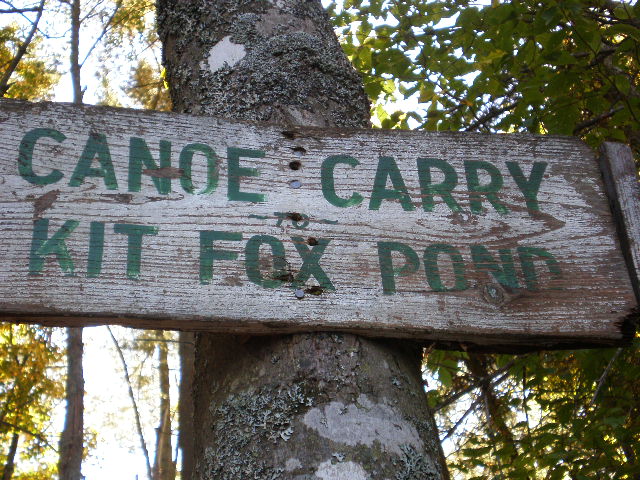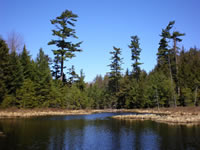 St. Regis Canoe Area
St. Regis Canoe Area
The St. Regis Canoe Area offers some of the best canoe camping in New York and is the only designated canoeing area in New York. The area contains 58 bodies of water and is a place where a canoeist can escape to serene canoe camping experience rarely found in today’s bustling civilization. Be warned that there are numerous portages involved in paddling the St. Regis Canoe Area and several of them being very strenuous. But once you experience the call of the loons, the serenity and pristine beauty, the unparalleled wildlife viewing, then most of the portages will only be a minor inconvenience.
Arranging a St. Regis Canoe Area trip is easy. You can arrange a loop trip by beginning and finishing your trip at that same access point, or a through trip by beginning at one location and finishing at another. This article describes a trip taken in early May 2007. We began our trip at the Upper St. Regis Lake and paddled to the St. Regis Pond where we established a basecamp for several days. By setting up the basecamp we had the freedom to explore the St. Regis Canoe Area without the hassle of carrying our gear over the most rigorous portages. The St. Regis Canoe Area offers a canoeing experience for paddlers of all skill levels. Day trippers will have plenty of opportunity to paddle and explorer the short routes while extended trip paddlers can embark on a three to five day adventure that nearly meets the expectations of a true wilderness trip. I say nearly meets expectations because this area of the Adirondacks is not as remote as sometimes described. Maybe with the exception of the winter months, you will encounter many other canoeists, hikers, campers and fisherman in the St. Regis Canoe Area.
Canoeing The Upper St. Regis Lake to St. Regis Pond
Don’t let the commercialized appearance of the Upper St. Regis Lake disappoint you because at your first portage out of the St. Regis Lake you’ll be leaving everything behind you for a more serene, secluded experience. Getting to St. Regis Pond from the St. Regis Lake can be completed in about three hours if you rush through it, or it could take an entire day if you take the time to explorer the small ponds on your way in. However you might consider rushing through this section to increase your chances of claiming a decent basecamp at St. Regis Pond. Getting to St. Regis Pond involves five portages from the Upper St. Regis Lake to Bog Pond, Bear Pond, Little Long Pond, Green Pond and finally to the St. Regis Pond. The portages involved in this journey from St. Regis Lake to the St. Regis Pond are not as lengthy as other portages you might encounter in the Adirondacks, and several of the portages in the section are very short only taking minutes, but you’ll still need to consider packing efficiently to avoid turning your canoe trip into an unpleasant portaging experience.
Paddling and Portage Descriptions
- Upper St. Regis Lake to Bog Pond – Paddling through the Upper St. Regis Lake will take about thirty minutes to an hour and isn’t a unique experience. You might experience wind, choppy water, boat houses and small amount of boat traffic. The short portage to Bog Pond is less than 100 yards and can be completed in only a few minutes.
- Bog Pond to Bear Pond – Paddling through Bog Pond takes only a few minutes. The portage from Bog Pond to Bear Pond is short taking only a few minutes.
- Bear Pond to Little Long Pond – Paddling through Bear Pond is also quite short but not as short as the paddle through Bog Pond. The portage to Little Long Pond is slightly longer than the Bog and Bear Pond portages but is still very manageable.
- Little Long Pond to Green Pond – Paddling through Little Long Pond takes a bit longer than paddling the previous smaller ponds. There are nice campsites at Little Long Pond if you don’t want to paddle through to the St. Regis Pond. The portage from Little Long Pond to Green Pond is longer than the previous Bog and Bear portages but are not too difficult to manage if you have packed your gear efficiently.
- Green Pond to St. Regis Pond – This is a very short paddle and portage. Just paddle straight through to the St. Regis Pond.
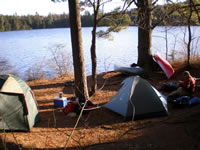 Camping at St. Regis Pond
Camping at St. Regis Pond
At approximately 1.5 miles in length the St. Regis Pond is much larger than the other ponds you’ve paddled on your way in. And with a dozen or more campsites available, the St. Regis Pond is considered one of the most popular camping areas in the Adirondacks, so expect some campsite competition when you arrive at this favorite spot of campers, canoers and fisherman. If you want to experience this area with less human activity consider visiting before Memorial Day or after Labor Day. The St. Regis Pond is an excellent choice for a basecamp for your first trip to the Adirondacks because of its easy access and convenient location to many of the other canoe trails in the St. Regis Canoe Area. You may want to consider planning your first day around arrival and setting up your basecamp; you could then spend what’s left of your first day paddling and exploring the pond. It’s a big pond and there is plenty to see. Fishing at the pond is rated as moderate so you may want to consider purchasing a license. There is also plenty of wildlife and nature photo opportunities, hiking trails as well as water trails.
Arrive at St. Regis Pond early because choosing your campsite at this location is an important consideration. This location is very popular with fisherman who know the area well and claim the best sites to settle in for several days of fishing. There are very nice campsites located on the island and several nice shelters campsites located on the shore of the pond, but they are often the first campsites occupied. On our trip we arrived late on a Friday afternoon and paddled around the pond for a while before locating a vacant campsite at the Southeast corner of the pond, near the portage trail to the Little Clear Pond. We got lucky with this campsite because it did block the relentless chilling wind that was present from early in the morning until later in the evening during all three days of our trip. The locals mentioned that it was unusually windy and cool for that time of year but the Adirondack trip reports I’ve read suggest this wind and chill might be normal for this time of year.
Starlight on St. Regis Pond
The evenings on St. Regis Pond were very calm in contrast to the daylight hours. In the evenings it was a relief once the winds began to calm and the skys began to clear. The first night of camping on St. Regis Pond was one of the most interesting nights of remote camping I’ve experienced. The starlit sky reflecting from the glass surface of the water and the call of the loons made for a spectacular and exciting show of nature each evening. A member of our group did a moonlight paddle that first night and I regret not joining him. I paddled on the pond the second night but it wasn’t as calm and was much cooler.
St. Regis Pond is as close as I’ve come to solitude wilderness camping. There was no presence of automobile traffic or aircraft sounds, and no sounds of human presence outside of our group except for the occasional laughter from the two fisherman camping about 75 yards above us. Nature dominated our surroundings. We had a jack rabbit run through the campsite early in the evening and the calls of the loons shot from across the pond throughout the night; this woke me several times but I can hardly complain.
Cold Temperature Warning: Very early in the mornings the temperatures dropped low enough that it became difficult to sleep. My sleeping bag is rated at 23 degrees and was not near rate low enough. If you plan on camping the Adirondacks before Memorial Weekend or in the fall be sure to take a sleeping bag rated for very low temperatures.
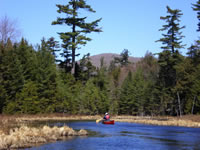 St. Regis Pond to Fish Pond
St. Regis Pond to Fish Pond
Early the second day we journeyed from St. Regis Pond to Fish Pond in the remote northern reaches of the St. Regis Canoe Area. And although you will not find complete seclusion at Fish Pond, getting there is a challenge that only a handful of paddlers will take on, so if you have the ambition to portage in your gear you could camp for several days while owning your own corner of the pond with the wildlife.
Fish Pond is where the portaging can get strenuous so we elected to paddle to Fish Pond instead of portaging. Not that paddling to Fish Pond is any easier than portaging, but because it guides you through a remote area only seen by a few hikers and canoeists we figured that if we are going to kill ourselves getting to Fish Pond we might as well create an unforgettable experience of it. Your paddle to Fish Pond begins at the West Branch of the St. Regis River on St. Regis Pond. This narrow, slow section is very interesting, there are plenty of photo opportunities, and fun, twisting turns through the narrow channel. Its shallow water winds through the remote wilderness area for about a half mile before eventually emptying into Ochre Pond. Once into Ochre Pond you’ll have to make the decision to continue your journey on the St. Regis River or attempt the exhausing portage to Mud and Fish Ponds. We chose to continue on the St. Regis River, and although I’m sure that I’m now a member of only a handful of paddlers that has experienced this remote section of the St. Regis River, it was challenging enough that I’m not sure if I’d do it again. On this section of the river we portaged through thick forest growth, dragged our canoes over beaver dams, over and under fallen pine and hemlock. We also discovered several deer carcasses that appeared to fall victim to coyotes.
Upon reaching Fish Pond where we were greeted by strong, chilling winds blowing relentlessly across the wide pond making it impossible to paddle efficiently or even point the canoes in the direction we needed to go. I was exhausted after forging my way down the St. Regis River and my canoe was driven by the wind into the shore despite my efforts. I gave up momentarily to muster some strength for another attempt into the wind with success. To avoid the overbearing winds we decided against exploring Fish Pond and we paddled straight to the Mud Pond portage trail where our interesting but exhausting paddle down the St. Regis River turned to an interesting but exhausting portage to Mud and Ochre Ponds.
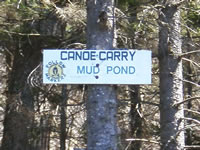 Portaging From Fish Pond to Mud Pond and Ochre Pond
Portaging From Fish Pond to Mud Pond and Ochre Pond
The portage trails between Fish Pond, Mud Pond and Ochre Ponds are one of the longest and most challenging portages in the St. Regis Canoe Area. The trek is made difficult by narrow trails, knee deep mud, and short steep grades, rocks and tree roots. On the trail near Mud Pond we did sink in the mud up to our knees in places, forcing us to actually drag our canoes through this watery section. You’ll need to endure this type of demanding portage for over a mile. On the bright side, while your traversing this old growth section of pine and hemlock you’ll be exposed to some excellent Adirondack scenery and unique vegetation such as the pitcher plant. The scenery on this trail is great but there is an optional portage on the logging road that provides easier portage around Mud and Ochre Pond and straight to the St. Regis Pond.
If your agenda is to camp several days in the secluded Adirondacks region then Fish Pond is the place to do it. You will encounter opportunities for superb wildlife and nature photography. The area is occupied by turtles, fish, beaver, bullfrogs, osprey, owls, loons, deer, coyotes, and maybe bear. It is a huge commitment to haul the gear in and out.

